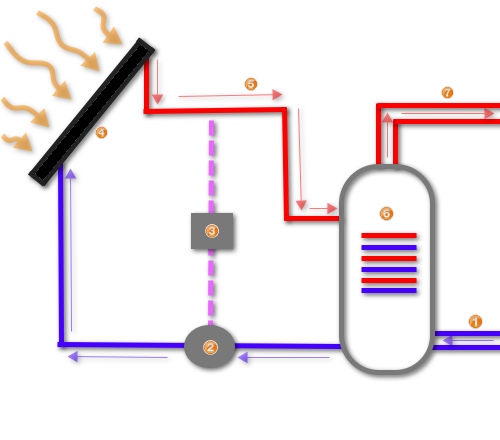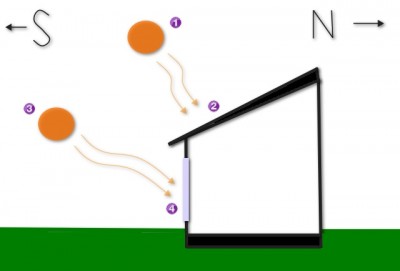Types of Solar Energy
There are many different types of solar energy systems.
Some are strictly for home use, some for large-scale commercial use, some create heat, and some create electricity.
It is easy to spilt the categories of the many types of solar energy systems in two ways: if the sun’s direct energy is harnessed into a heat energy form, or if the sun’s energy is converted into an electrical energy form.
When the sun’s energy is harnessed into heat energy, we mean that the the sunlight is essentially gathered and used for heating. For example, when you leave a parked car in the sunlight all day and the inside collects heat, or when the shallow end of a swimming pool becomes noticeably warmer as it harnesses the sunlight on a hot day. These examples of harnessing the sun’s heat can then categorized into two different solar energy types:
(1) Passive Solar Energy: is the use of strategically oriented walls, windows, and architectural features — usually of a home — that are designed to absorb and deflect the sun’s energy without the use of any mechanical or electrical devices.
The goal of passive solar heating is to reduce the cost of electrical heating during colder months of the year, while also keeping a home cooler during the warmer months of the year.
The diagram below is a simple model of a home designed for passive solar energy.
The diagram above of passive solar heating is a generic image of the side of a house that is strategically oriented to absorb the sun’s heat in the winter and deflect the sun’s heat in the summer.
- The sun labeled (1) is an example of a summer sun in the Northern Hemisphere because it is higher in the sky when oriented with solar south.
- The rays of the summer sun are absorbed or reflected off the specially designed roof of the house which keeps the house cooler in the summer.
- The winter sun is closer to the horizon.
- The strategically placed window of the house is designed to let in the heat of the winter sun, which will keep the house warmer during the winder and hopefully result in lower energy usage to heat your home.
(2) Active Solar Energy: uses an active electrical device to power the solar energy system, such as a water pump or an electrical power control box. Because of this requirement, an active solar energy system requires extra power, besides the sun, to operate and maximize the efficiency of the system.
Active solar systems come with advantages and disadvantages. The obvious advantage of the active system is that the outside power source increases the efficiency of the system. Another advantage is that it makes controlling the system much easier by offering controls to turn the machine on and off, and also to adjust specific options of the machines, such as temperature.
A few disadvantages are that an extra mechanical device increases the cost of the system. It may help the system save money in the long run, but the initial cost of construction will be higher. Also there is a greater probability of future maintenance costs on the machine because of the extra components. Lastly, if the active device malfunctions, the machine could be rendered useless until the device is fixed, something that cannot happen to a passive solar energy system.
A very most common active solar energy system is a solar water heater. A solar water heater is a solar power system that uses the sun’s heat to heat water for your home.
A home solar water heating system could use either photovoltaic solar panels or a concentrated solar power system to generate the heat needed to raise the temperature of the water.
There are a few different strategies for solar water heating, below is a simple example of a simple home solar water heating system.
This system is considered an active solar power system because it requires a pump, or an outside mechanism to run the water through the machine.
 The above diagram is an example of a home solar thermal system used to heat water. The solar water heater uses the heat from the sun to increase the temperature of the water in your home.
The above diagram is an example of a home solar thermal system used to heat water. The solar water heater uses the heat from the sun to increase the temperature of the water in your home.
- The water heater is attached to a cool water source.
- A small pump, which could be powered by batteries or an electric source, sometimes by a the solar panel itself, pumps water through the solar thermal heater.
- The controller is the mechanism that controls the system and could be installed in the home. The controller can set the temperature and other options of the water heating system.
- The solar thermal panels, mounted outside or attached to the outside of the home, collect the sun’s energy and use it to heat water to high temperatures.
- The now heated water is pumped back towards the water heater.
- The water heater stores the heated water until it is needed in the household. The heater may also be capable of heating water on it’s own in case the panels do not receive enough sunlight to operate.
- The water from the solar heater can now be directed towards the faucets of your home.
Since the sun does not shine all night or every day, the solar water heater is still able to use regular on-grid electricity to heat water on it’s own. When the sun is shining, the on-grid electric power is shut off and the water heater uses the water heated from the sun instead, saving your home energy and money.
Another example of an active solar system is a photovoltaic solar panel array that is mounted on a tracking system. The tracking system of the solar panel moves the face of the panel to follow the sun’s movement in the sky throughout the day. These active tracking systems can dramatically increase the efficiency of solar panels.
Again, an active solar energy system is a solar power system that requires outside energy to operate the system.
Converting The Sun’s Energy into Electricity: When the sun’s energy is converted into another form of energy, usually electricity, we can split this category into three types of solar energy:
(1) Photovoltaic Cells (PV): these cells use the photons from sun’s light to create electricity. A majority of solar panels used today are in the category of photovoltaic cells. Learn how solar panels work.
(2) Solar Turbine – Concentrated Solar Power: when the sun’s heat is converted into electricity. Learn how a solar turbine works.
Each type of solar energy system works differently, but they are all initially powered by the heat or light energy emitted from the sun.
